
“How do we make the modern city habitable for those who experience it primarily as a site of alienation and dispossession? The goal is no longer to invent a new world of forms or to invent a new world through forms. The goal is to learn to inhabit ruins.”
University of Washington anthropologist Danny Hoffman stood outside the Hotel Africa on the outskirts of Monrovia, Liberia. Before the nation’s fourteen-year civil war, West African elite and global investors gathered at the resort to escape the noise of the city. Now, like much of the capital, the hotel was in ruins. At Hoffman’s feet lay the hotel’s centerpiece, an empty swimming pool in the shape of Africa.
The pool seemed to offer a forlorn commentary on the failed hopes of a pan-African prosperity. As a seasoned photojournalist, Hoffman knew how to spot a metaphor when it gaped up at him from the ground. But as a thoughtful scholar, he also knew how to spot a cliché.
Using the pool as a cheap symbol wouldn’t bring him any closer to his goal of studying how Monrovia’s future is shaped and constrained by its urban forms. He took a photograph and kept moving, discovering throughout the city a richer and more complex portrait of the way architecture influences a city struggling to move forward.
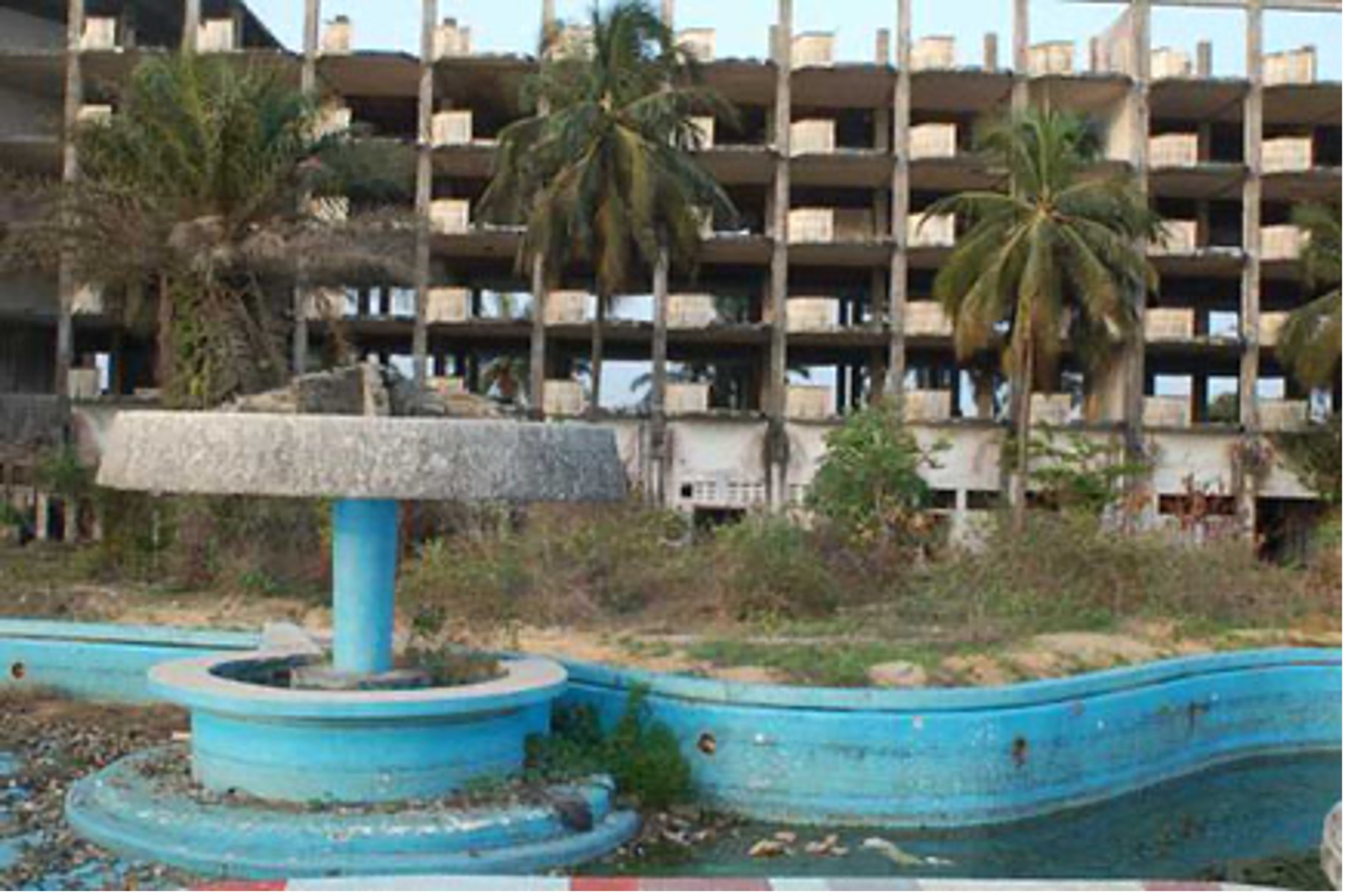
The resulting book, Monrovia Modern: Urban Form and Political Imagination in Liberia (Duke University Press, 2017), follows former fighters as they move throughout the capital making a living and finding homes in abandoned spaces. The book departs from typical approaches of both architectural criticism and post-conflict ethnography, though it draws fruitfully on both. Hoffman brings an anthropologist’s sensibility to architecture studies, examining buildings not as they look but as they’re actually used. He combines text and image in a form he calls “photowriting” to show how the practice of photography itself shapes how we see buildings.
In weaving these strands together, he shows how Liberians struggle to envision a civic future that does not rely on military strongmen. More broadly, he shows how photographing everyday architecture can reveal the ways that built forms shape how people live within them. Just as a town with private shopping malls but no public squares encourages some activities over others, a postwar city with ruins but little middle-class housing enables residents to imagine some futures but not others.

The book offers a novel approach for thinking about how to live well in places shaped by the hopes and the failures of the past.
“How do we make the modern city habitable for those who experience it primarily as a site of alienation and dispossession?” Hoffman asks. “The goal is no longer to invent a new world of forms or to invent a new world through forms. The goal is to learn to inhabit ruins.”
Postwar Life
Hoffman had seen plenty of ruins as a photojournalist based in Johannesburg. After graduating from Princeton in 1994, he spent four years as a freelancer reporting for news outlets and NGOs from conflict zones in Angola, the Congo, Somalia, Mozambique, and the Balkans. The work taught him how to report on warfare, and also how to recognize the standard tropes of Western photography in Africa: unspoiled natural beauty, overwhelming poverty, chilling depictions of child soldiers, and others. He returned to the US for graduate school at Duke University, conducting his ethnographic fieldwork in Sierra Leone and Liberia.
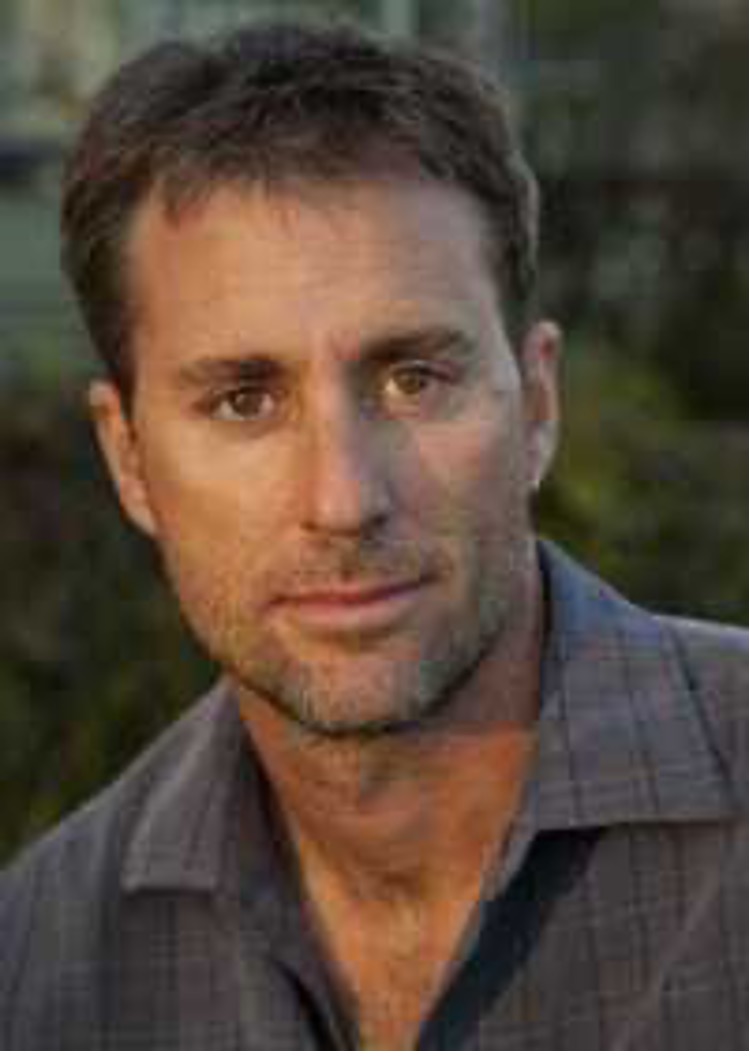
His first book, The War Machines (2011), documented the lives of young Sierra Leonean and Liberian men forced into militias during the country’s civil wars. The book interprets warfare as a form of labor, a means of deploying the bodies of teenage males to extract security and wealth, much like diamond mining.
In the years that followed, Hoffman grew curious about Monrovia’s built landscape of ruined towers, slums, squatter settlements, and a crippling lack of infrastructure. Whatever came next for Liberia, which ranks 177th in the UN Human Development Index, it would begin within the context of these physical forms.
The end of combat in Liberia led in 2005 to Africa’s first democratically elected woman head of state, Ellen Johnson Sirleaf. But the years that followed were marked by unemployment, currency shortages, and an overwhelming sense of uncertainty. After years of instability, the ownership of property was frequently contested or unclear, discouraging anyone, rich or poor, from making long-term investments. When Hoffman asked Monrovians to describe a better life for themselves, they almost unanimously envisioned themselves elsewhere—returning to ancestral villages, or immigrating to New York.
He was surprised by how many people said they would accept the return of a strongman like Charles Taylor, whose brutal rule was at least marked by predictability and less street crime than now.
“The absence of a strong man had not yielded a more benevolent, participatory, or democratic state,” he writes. “It had produced a more crushing form of authoritarianism in the form of extreme uncertainty.”
That uncertainty was on full display during his research trip in the spring of 2012. In Monrovia Modern, he recounts meetings with former soldiers like Arthur Kollie, who insists on going by his war name, Major General Human Garbage. Kollie shows him the unfinished state building where he once squatted, then the small room behind a makeshift plywood door where he keeps his possessions. He tells of his military rank, though it is unclear to Hoffman exactly which military group he belonged to. Kollie identifies a nearby woman and baby as his wife and child, although another former fighter tells Hoffman the story is untrue.
“Can you imagine,” the onlooker says. “The man had two stars, two jeeps. Women. Now Human Garbage doesn’t even have a door.”
Elsewhere, Hoffman witnesses a tense exchange between his guide and a building’s self-appointed security guards. The men all reference years spent “fighting for the country” while being careful not to identify the factions to which they belonged. Another ex-soldier, Koffi, shows him the taxi stand where men practice cell phone-jacking: grabbing a phone from a distracted taxi passenger, disappearing into a nearby slum, and using intermediaries to try to extract a ransom. Others describe a life of constant movement throughout the city, storing personal effects at multiple dwellings and searching for day work as it arises.
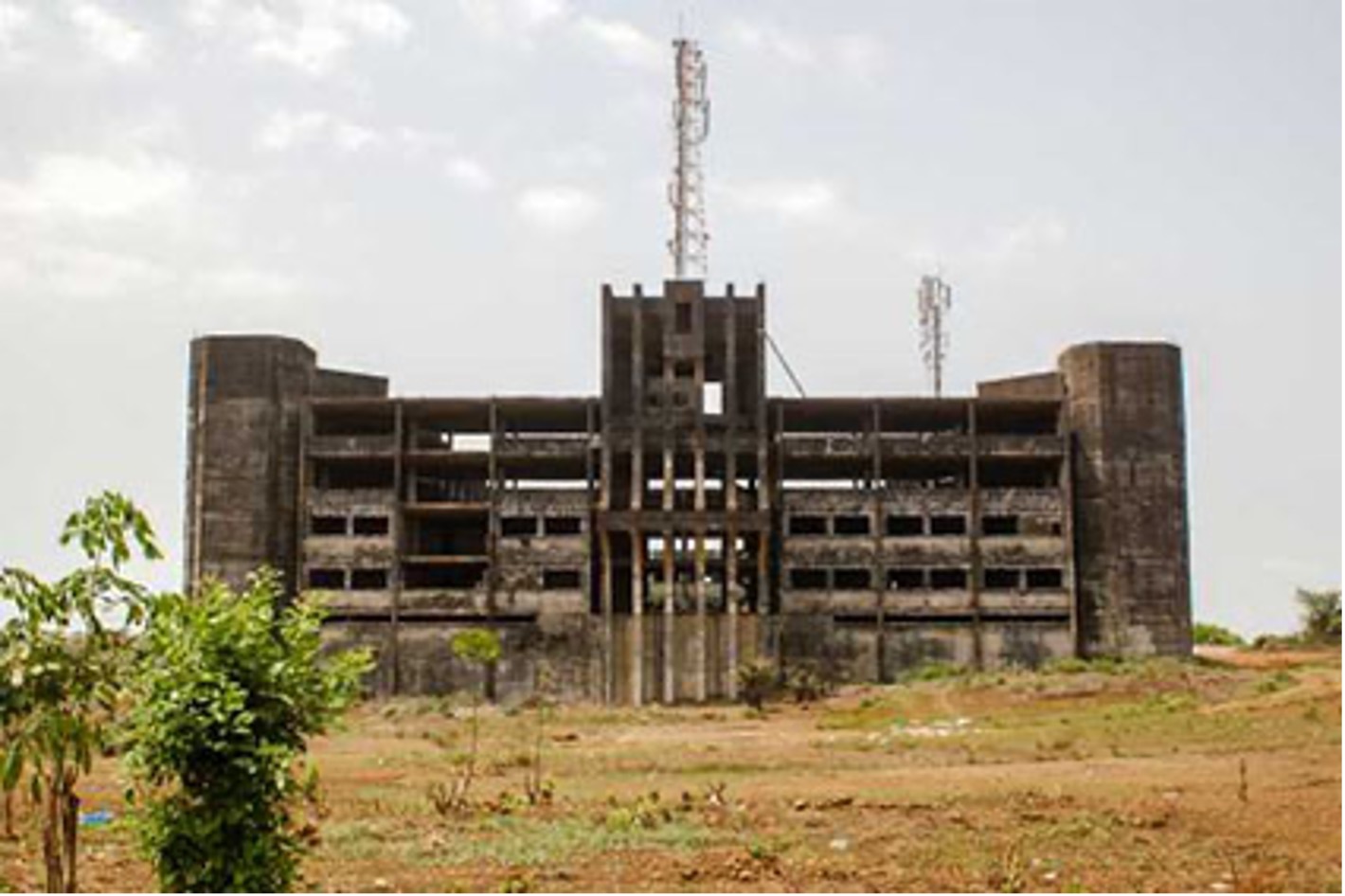
When former fighters were told to vacate abandoned buildings, Hoffman was struck by how quickly they complied. He found no examples of successful organizing among squatters. He attributes this in part to the lack of squatter’s rights in Liberian law. His growing interest in architecture studies offered an additional explanation: The very structure of these buildings, which were never intended to be homes, seemed to resist attempts to make dwellings out of them.
Decolonizing Architecture
Like Lagos, Nairobi, and other sub-Saharan African cities, Monrovia experienced some of its fastest growth in the mid-20th century, when the influence of architectural modernism was at its highest. The architectural movement, at its idealistic core, believed that social uplift was possible through benevolent design. It found some of its fullest expressions in those relatively young cities, often by young architects out to make a name in less-regulated markets. Yet the movement’s most-celebrated and photographed models tend to be in Europe, North America and, to some extent, in Latin America.
This matters, Hoffman realized, because architecture is fundamentally a visual form, with influence transmitted through images. Even the most well-traveled architects have studied more buildings through photographs than by visiting them in the field. In researching Monrovia Modern, Hoffman took courses in architecture at the UW and through the Architectural Association in London, supported by a New Directions Fellowship from the Andrew W. Mellon Foundation. He saw the importance of “reference buildings”—standout examples that play an outsized role in architectural education. Most of these examples are located in climates and political contexts far from West Africa.
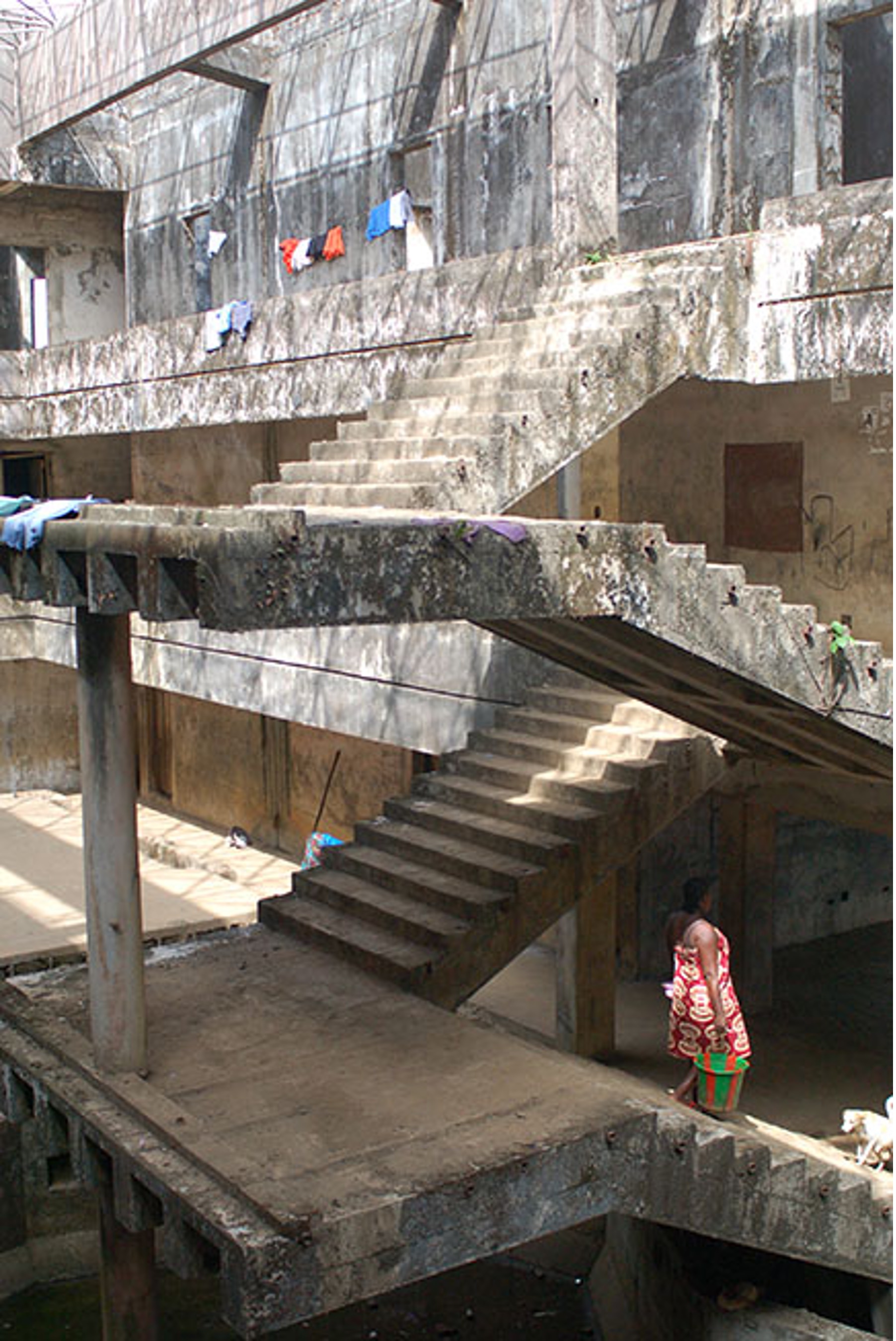
“Most of what design ends up being is playing with these inherited forms,” Hoffman said in a conversation. “If design work in Lagos or Kinshasa was part of that celebrated architectural patrimony that gets taught in schools, you’d have a different conversation about how to design with climate in mind, about radical aesthetics, about how you include people’s real needs in a project, and about how you work with minimal budgets.”
While Liberia was never formally colonized, it faced many of the same colonial influences as other sub-Saharan nations, including U.S. aid that benefitted only a small elite. Part of decolonizing its heritage, Hoffman argues, is recognizing that Monrovia has much to teach critical scholars of modernism.
“Ironically,” Hoffman writes, “it is the urban spaces least visible in the critical thinking about modernism and its legacies that provide the richest ground for understanding how urbanites live in modernism’s spaces.”
Monrovia in Four Buildings
Monrovia Modern is structured around four buildings. The first is the Ministry of Defense headquarters commissioned under the violent leader Samuel Doe. It was designed and begun by an Israeli firm but never finished, its austere concrete mass hulking on the edge of the city. Its chief influence is brutalism, a style meant to project transparency and egalitarian integrity through clear layouts and a lack of ornamentation. Doe repurposed the style to project menacing militaristic strength. In Hoffman’s photos, men stand awkwardly within its massive impersonal proportions.
Next is the E.J. Roye Building, a damaged corporate tower that once hosted the national beauty pageant. Its original design, a generic office plan that could be anywhere, reflects a capitalist sensibility devoid of local culture or politics. Hoffman’s photos contrast the orderly symmetrical lines with the blown-out gaps and jagged edges of history imposing itself.
At Hotel Africa, he found one of West Africa’s premier luxury hotels reduced to a condition unsafe even for wandering, its rubble-strewn floors pocked with dangerous holes from visitors harvesting materials.
People are fascinated with ruins, Hoffman says, because of their implicit commentary on the false promises of capitalism, technology, and modernity. But he questions whether these critiques lead anywhere productive. For ruins to work as a space of critique, their relationship to the future is as important as their connection to the past. To interpret a shuttered Rust Belt factory, we might consider the corporate executives who moved manufacturing jobs overseas. We might question the tax policies and quarterly-earnings incentives that reward them for doing so. But the only author of Hotel Africa’s decline is the vast impersonal warfare that renders absurd the idea of a restful vacation in Monrovia, Hoffman says.
“What is left is unreadable,” he writes. “It is form without critical possibility, more rubble than ruin.”
His final building is the unfinished headquarters of the Liberian Broadcasting System, which has an external structure every bit as grandiose and brutalist as the Ministry of Defense. Inside, however, a transparent ceiling and open interior cavern send dappled light filtering downward. As Hoffman’s photos show, quotidian domestic life is imaginable in this space. He captures the signage of food vendors, women washing laundry and watching babies, and a young girl climbing playfully through its jungle-gym spaces.
Rather than using poetic imagery to gloss over large structural problems, Hoffman zooms in closer. The building’s original large-scale intention of supporting connectivity through radio had failed. But its new residents have begun new small-scale activities that do not require a strongman. Hoffman finds promise in the “minor architecture” movement away from grand social-engineering projects and toward flexible design that can be adapted by users. This direction might lead closer to the still-unrealized potential for a distinctly African architecture, he says.
Inhabiting Ruins
“Monrovia’s history has been a difficult one,” Hoffman writes. “Its future will be as well.”
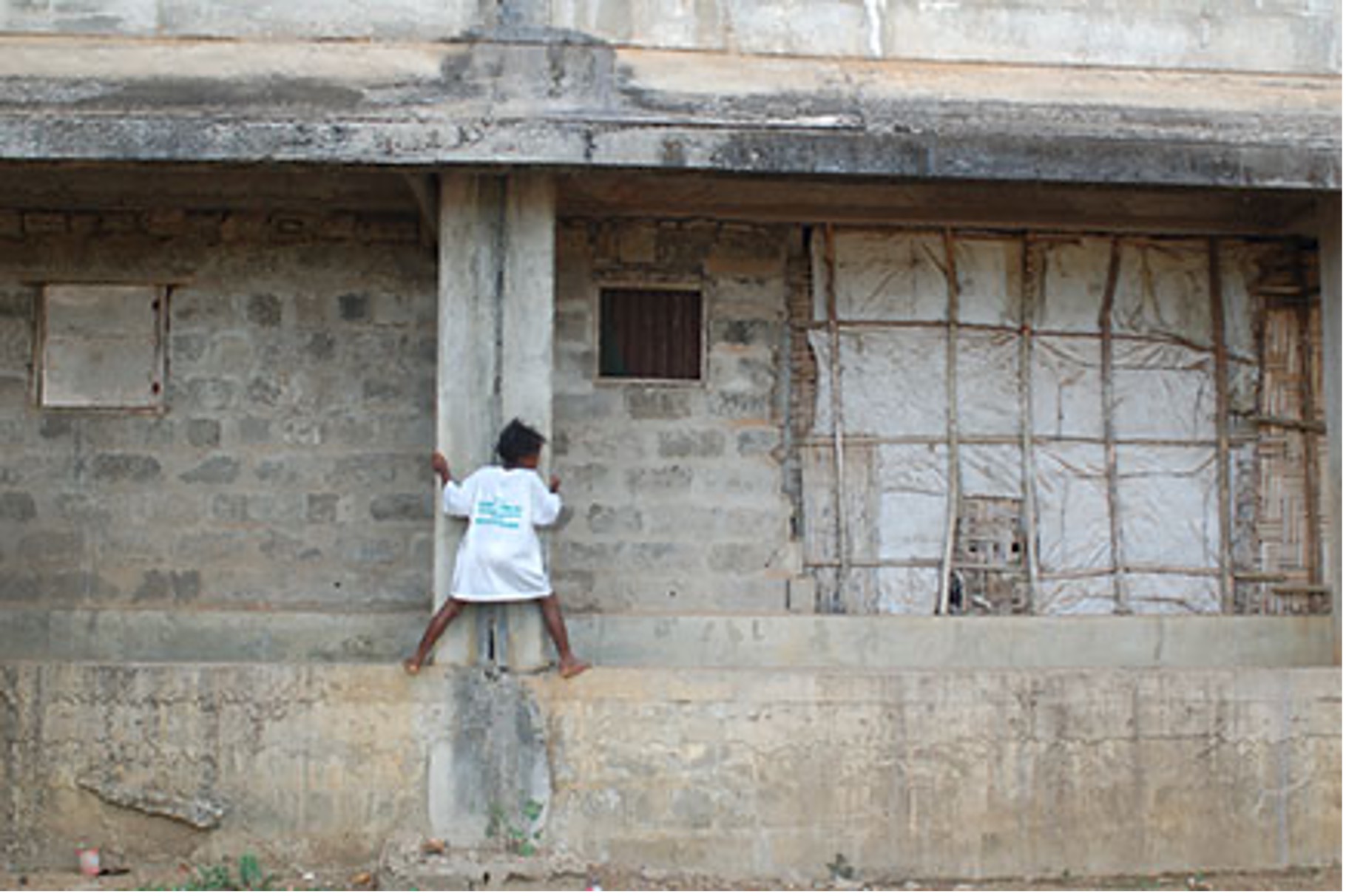
Since the book’s publication last fall, Liberia has completed its first peaceful transfer of power in more than 70 years, with Sirleaf succeeded by the soccer star George Weah. The nation’s pathway to a better livelihood will not look exactly like developmental pathways elsewhere. It may involve recognizing mobile lifestyles as just as legitimate as static home ownership.
Hoffman, who is turning his research toward the interaction of US military forces and private security entities in foreign cities, has continued to experiment with form, publishing an arresting photo essay on diamond mining and submitting a short documentary to film festivals. In an essay in Africa is a Country in response to the 2014 Ebola outbreak in Liberia, he argues that US security forces should supplement urban combat training with skills in non-lethal crowd control and disease tracking.
His work joins a broader exploration by UW scholars into “partnerships” between U.S. and African organizations and how they can honestly reckon with power imbalances, whether they are study abroad trips, medical interventions, or ethnographic research trips. His work also fits into a series of experiments into scholarly forms by ethnographers and other scholars exploring how to conduct and distribute scholarship in a continually changing world.
In developing the conceptual framework for Monrovia Modern, Hoffman found inspiration in a brief line of Martin Heidegger’s that signals the necessity of reinvention for anyone, at any stage of life.
“Mortals,” the German philosopher writes, “must ever learn to dwell.”
Danny Hoffman’s work on Monrovia Modern was supported by a 2015-2016 Society of Scholars Fellowship from the Simpson Center for the Humanities. His architecture studies were supported by a New Directions Fellowship from the Andrew W. Mellon Foundation.
